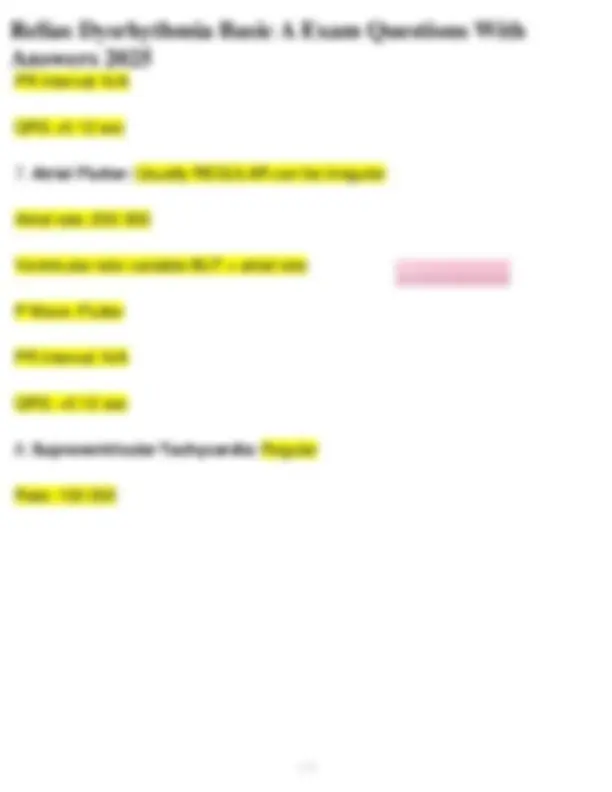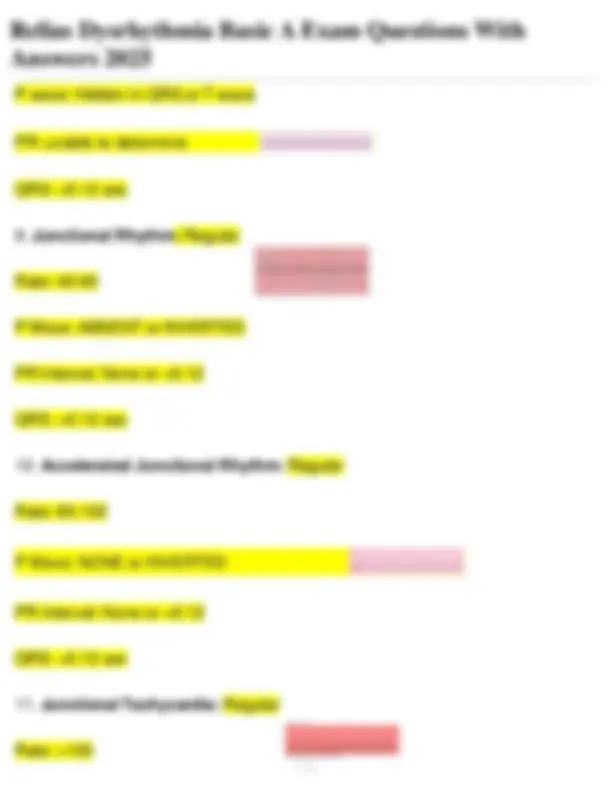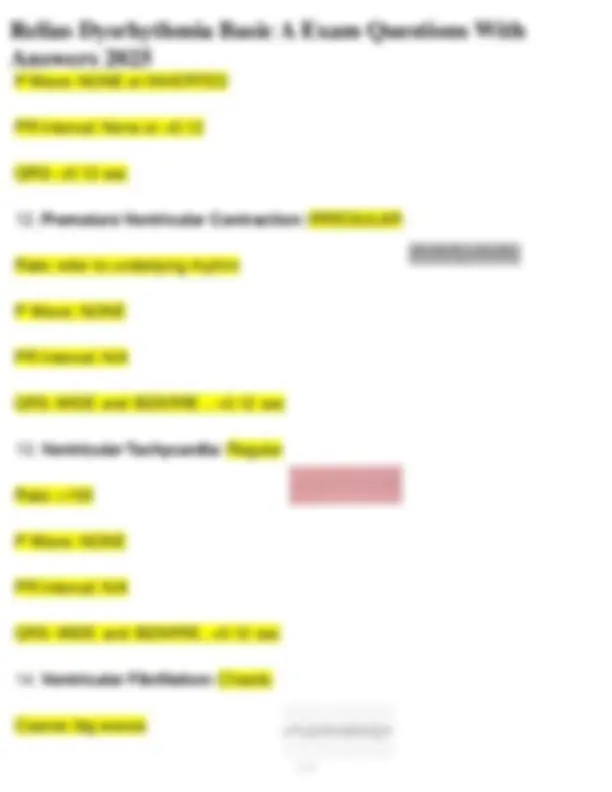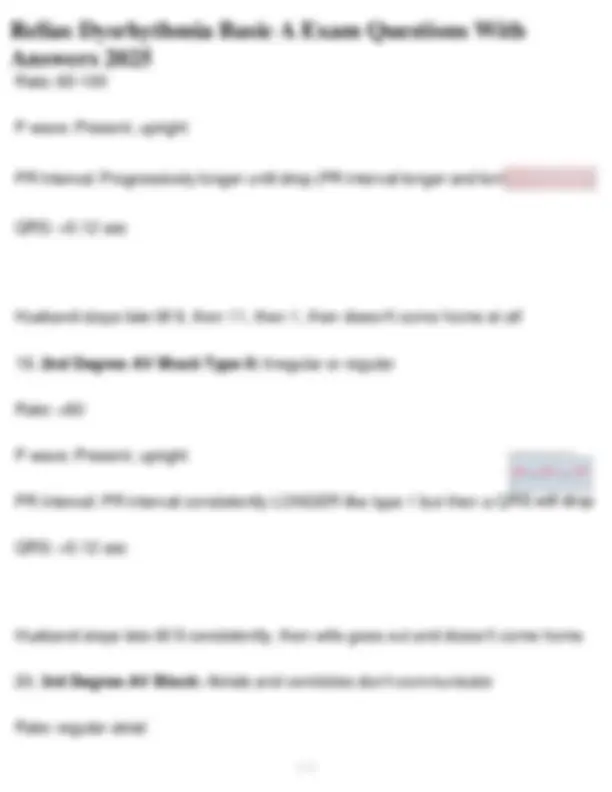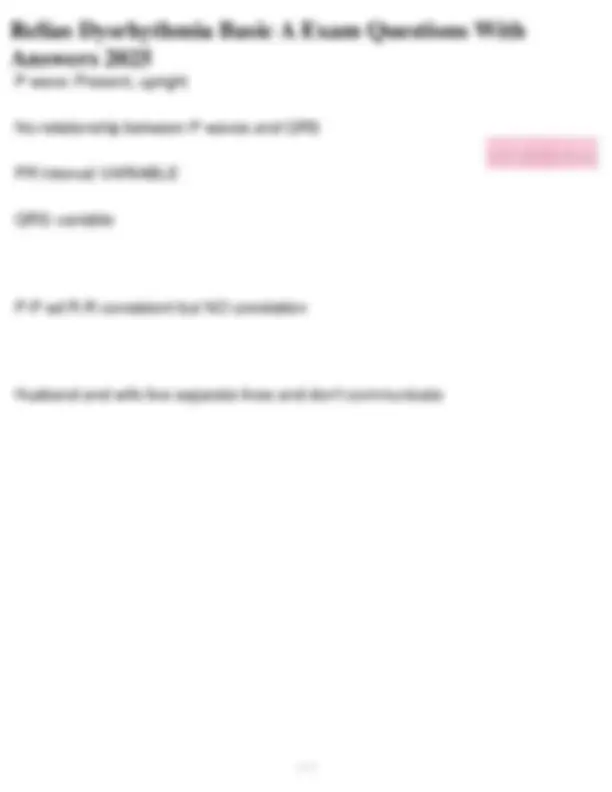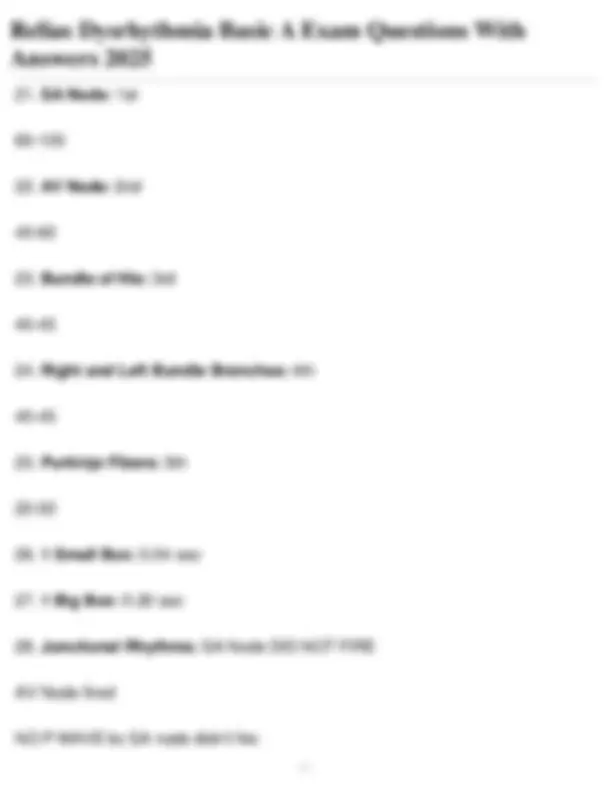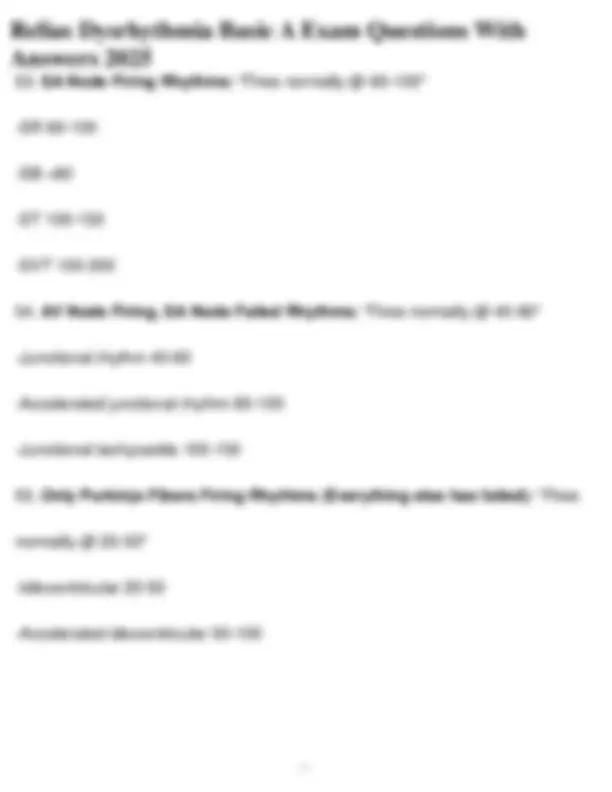Download Relias Dysrhythmia Basic A Exam Questions With Answers 2025 and more Exams Nursing in PDF only on Docsity!
Answers 2025
Relias Dysrhythmia Basic A Exam Questions With
Answers 2025
- Normal sinus rhythm: Regular Rate: 60 - 100 P Wave: Present, upright PR Interval: 0.12-0.20 sec QRS: <0.12 sec
- Sinus Bradycardia: Regular Rate: < P Wave: Present, upright PR Interval: 0.12-0.20 sec QRS: <0.12 sec
- Sinus Tachycardia: Regular Rate: 100 - 150 P Wave: Present, upright PR Interval: 0.12-0.20 sec
Answers 2025 QRS: <0.12 sec
- Premature Atrial Contraction: IRREGULAR Rate: depends on underlying rhythm P wave: Present or hidden in T wave PR Interval: 0.12-0.20 sec QRS: <0.12 sec
- Atrial Fibrillation: IRREGULAR Atrial rate: UNMEASURABLE Ventricular rate: variable P wave: unable to see PR Interval: N/A QRS: <0.12 sec
- A fib RVR: IRREGULAR Ventricular rate: 100 - 175 P wave: unable to see
Answers 2025
P wave: Hidden in QRS or T wave PR: unable to determine QRS: <0.12 sec
- Junctional Rhythm: Regular Rate: 40 - 60 P Wave: ABSENT or INVERTED PR Interval: None or <0. QRS: <0.12 sec
- Accelerated Junctional Rhythm: Regular Rate: 60 - 100 P Wave: NONE or INVERTED PR Interval: None or <0. QRS: <0.12 sec
- Junctional Tachycardia: Regular Rate: >
Answers 2025 P Wave: NONE or INVERTED
PR Interval: None or <0. QRS: <0.12 sec
- Premature Ventricular Contraction: IRREGULAR Rate: refer to underlying rhythm P Wave: NONE PR Interval: N/A QRS: WIDE and BIZARRE , >0.12 sec
- Ventricular Tachycardia: Regular Rate: > P Wave: NONE PR Interval: N/A QRS: WIDE and BIZARRE, >0.12 sec
- Ventricular Fibrillation: Chaotic Coarse: big waves
Answers 2025
PR Interval: N/A QRS: WIDE, >0.12 sec
- Accelerated Idoventricular Rhythm: Regular Rate: 50- P wave: NONE PR Interval: N/A QRS: WIDE, >0.12 sec
- 1st Degree AV Block: Regular Rate: 60- P Wave: Present, upright PR interval: >0.20 sec CONSISTENTLY LONG QRS: <0.12 sec
Husband stays late till 9 consistently
- 2nd Degree AV Block Type I Mobitz, Wenckebach: IRREGULAR
Answers 2025
ger until drop)
RS will drop
Rate: 60- P wave: Present, upright PR Interval: Progressively longer until drop (PR interval longer and lon QRS: <0.12 sec
Husband stays late till 9, then 11, then 1, then doesn't come home at all
- 2nd Degree AV Block Type II: Irregular or regular Rate: < P wave: Present, upright PR Interval: PR interval consistently LONGER like type 1 but then a Q QRS: <0.12 sec
Husband stays late till 9 consistently, then wife goes out and doesn't come home
- 3rd Degree AV Block: Atrials and ventricles don't communicate Rate: regular atrial
Answers 2025
- SA Node: 1st 60-
- AV Node: 2nd 40-
- Bundle of His: 3rd 40-
- Right and Left Bundle Branches: 4th 40-
- Purkinje Fibers: 5th 20-
- 1 Small Box: 0.04 sec
- 1 Big Box: 0.20 sec
- Junctional Rhythms: SA Node DID NOT FIRE AV Node fired NO P WAVE bc SA node didn't fire
Answers 2025 Narrow QRS
- P Wave: Amplitude 0.5-2.5 mm Will be shorter than T wave Shows firing of SA node
- QRS: 0.06-0.10 sec SHOULD BE <0.12 sec Wide QRS: delay in ventricular contraction, delay of conduction through bundle branches or purkinje fibers BUNDLE BRANCH BLOCK or BLOCK IN PURKINJE FIBERS (idioventricular)
- Calculate Regular Rate: 1500/ # boxes R-R
- Calculate Irregular Rate: # of Rs in 6 sec strip X 10
- Unifocal PVCs: Only 1 shape PVC
- Bigeminy: PVC occurs every OTHER beat
- Trigeminy: PVC occurs every THIRD beat
- Couplet: 2 PVCs together
- Triplet: 3 PVCs together
Answers 2025
n
- Idioventricular Rhythms: Only purkinje fibers firing WIDE QRS always
- Atrially Paced: Spike comes before P
- Ventricularly Paced: Spike comes before QRS and QRS will be wide
- AV Paced: Spike before P and before QR
- Failure to Capture: Spikes with no QRS
- Failure to Sense: Spikes happen regardless of QRS on their ow
- How to determine the rhythm: Regular or irregular? Rate? P before every QRS? QRS for every P? QRS wide or narrow?
- QT Interval: 0.34-0.
- P Wave: 0.06-0.12 sec
- PR Interval: 0.12-0.20 sec
Answers 2025 53. SA Node Firing Rhythms: Fires normally @ 60-100
-SR 60-
-SB <
-ST 100-
-SVT 150-
- AV Node Firing, SA Node Failed Rhythms: Fires normally @ 40-60 -Junctional rhythm 40- -Accelerated junctional rhythm 60- -Junctional tachycardia 100-
- Only Purkinje Fibers Firing Rhythms (Everything else has failed): Fires normally @ 20-50 -Idioventricular 20- -Accelerated idioventricular 50-

